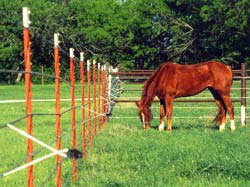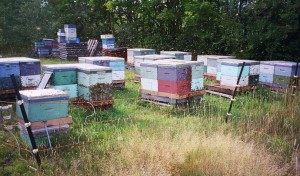-
0 Cart: $ 0.00
Start near the fence chargers lead-out wires with your Speedrite Remote with Fault Finder or your Speedrite Fault Finder. Move down the fence line following the arrow away from the energizer. Take readings at regular intervals and at any junction point.
Fix fence as needed when you find a problem. Do this along the entire fence.

Use this electric fence voltage chart as a guide for your animal requirements
Beef Cattle
2,000 - 3,000 V
Bulls require a higher voltage as more aggressive.
Dairy Cattle
2,000 V
If kept separately, calves and heifers require lower wires and
less spacing.
Horses
2,000 - 3,000 V
Intelligent, learn quickly, easy to control. A fence made of
politape, wire or rope is less likely to injure if a spooked horse
tries to run through it.
Llamas
4,000 - 5,000 V
Thick coats insulate from electric shocks so require higher voltage.
Deer and Elk
4,000 - 5,000 V
Spook easily and jump higher than most other animals.
Above head height, electric high tensile fence recommended.
Space wires close enough to prevent stepping through or heads
between wires.
Sheep
4,000 - 5,000 V
Wool insulates from electric shocks so require higher voltage.
Goats
4,000 - 5,000 V
Some species have thick insulating coats requiring higher voltage.
Tend to test fences - space wires low to ground and high enough to
prevent being jumped.
Pigs
2,000 V
Start wires close to ground as rooting animal and finish at nose level.
Pets
700 - 1,000 V
Start wires close to ground.
Keep Out
Wild Hogs
5,000 V
Aggressive and persistent. Deter from rooting by starting wires
close to ground.
Wolves and Coyotes
4,000 - 5,000 V
Very thick, insulating fur requires high voltage. Can dig to reach
prey so place first wire low to the ground.
Bears
5,000 V
Thick, insulating fur requires high voltage. Bait fences to train
avoidance.
Deer and Elk
4,000 - 5,000 V
Move quickly and often run through fences unseen so make fence
highly visible.
Small Nuisance Animals
1,000 - 2,000 V
Start wires close to ground as small and most species prone
to digging.


Some bears are especially fond of larval bees and honey and will actively seek out hives in their home range. Consequently, beehives should be located as far as possible from timber and brush providing bears with cover and travel routes. Honey crops should be harvested as soon as possible after the spring, summer and fall nectar flows to reduce the attractiveness of hives to foraging bears, and prevent the loss of the new honey crop in the event of depredation. When possible, apiaries should be moved to new locations if bear activity is detected nearby.
To minimize possible damage to hives and prevent bears from establishing bad habits, apiaries in occupied habitat should be protected using electric fences, or at a minimum use bear-resistant platforms (with an overhang more than two metres above the ground).
Electric fencing has been shown to be almost 100 per cent effective in deterring bear damage. Compact apiaries are easier to protect with bear-resistant fencing than those scattered over a larger area, so beekeepers should consolidate hives to form the smallest apiary that can be practically managed.
Other references: Download Building a Secure Beehive Enclosure
Enjoy this great video about T-Heart Ranch in Colorado. They purchased a Gallagher Cattle Scale from us this year. The specialize in high altitude cattle genetics.
Cowboy Calendar - Beef Today Events | Agweb.com
Sustainable agriculture is not just for winning conservation awards, it can also provide economical practices that make farming financially feasible. That’s the belief of Arthur Keys and his wife, Jasna Basaric-Keys, owners of Keystone Farm and winners of the Washington County Conservation District’s 2015 Conservation Farmer of the Year award.
Keys spent years in Washington, D.C., both lobbying for and overseeing the implementation of agriculture and development in the United States and abroad. “The agricultural industry is the No. 1 industry in many thirdworld countries,” Keys said. “Therefore, economic aid often comes in the form of sustainable agriculture practices. “The use of better practices can also aid in the overall health of an area,” he said. “I wanted to test some of the same theories used elsewhere right here in southwestern Pennsylvania to see how similar it would be.” Keys and Basaric-Keys bought their 270-acre farm in 2005, and since it had been out of production for well over five years, they were able to immediately have the pastures certified as organic for their registered Hereford herd to graze.
They, along with Lynn Bayne, their farm manager, set to workimplementing additional measures to ensure efficient operation through sustainable practices. “We began an intense invasive weed eradication whereby we manually and mechanically removed multiflora roses and tree of heaven from our woodlots and pastures,” Keys said. “We implemented a regular system of soil testing and apply limestone as needed,” he said. “We began streambank fencing and rotational grazing as well.” Basaric-Keys, a former biologist, is a proponent of rotational grazing. “The rotational grazing is not only healthy for the grasses, but it also naturally reduces parasites in the cattle,” she said. The rotational grazing allows the cattle to be on pasture 12 months a year, minimizing confinement and naturally dispersing manure, eliminating the need for fertilizer applications.
Free-choice minerals fed to the cattle are naturally dispersed to the grasses through the manure. The cows typically have access to the woodlots during the hottest and coldest months of the year, when they need shelter. “Our nine miles of fencing is probably our best economic practice to date,” Keys said. “We are utilizing all of the available pasture space now, and we stockpile pasture in the hayfields that we then temporarily fence off during the months when the other pastures are low.” Accompanied by a pump station and an all-weather hydrant system that allows water from one of the ponds to be drawn into temporary tanks in previously inaccessible fields, the additional pasture means less hay is fed, creating an opportunity for selling any surplus.
Keystone Farm also boasts a 1-acre pollinator field, where wildflowers Continued from A1 encourage bees and other pollinators that will benefit the blooming grasses, such as clover, in the pastures. “We have worked with the Natural Resources Conservation Service and the (county conservation district) to implement programs with impact,” Keys said. “We have a volunteer nutrient management plan, a manure management plan, established wildlife habitat areas, solar panels that electrify the barn and fences, and squirrel ladders in our gravity-fed troughs,” he said. Keys and Basaric-Keys are looking toward the future and how they can continue to become more sustainable and, therefore, more profitable.
They are considering geothermal troughs buried deep in the ground to keep the water from freezing, which would eliminate the labor of breaking ice and provide constant water for the cattle. They are also thinking of placing additional birdhouses around the ponds for insect and mosquito control, and they are contemplating ways to repurpose their silos, and improve their roads and runways. “We are proud of our accomplishments as well as this award,” Keys said. “But there is still much to do.”
Photos by Laura Zoeller This pond provides water so cattle can graze pastures that previously had inadequate water sources. Arthur Keys and Jasna BasaricKeys pose in their home a few days after receiving the award. Keystone Farm’s registered Hereford cattle graze 12 months a year on certified organic pastures. A dozen solar panels fully supply the fences and the barn with power.
A female prisoner has been charged after her escape attempt from a Hobart prison failed at the final hurdle.
The 35-year-old was charged on Monday night after she was caught in the electrified cyclone fencing atop the outer perimeter fence of the Mary Hutchinson Women's Prison in Risdon Vale.
She was cleared of injuries by the prison's medical staff, police said on Tuesday.